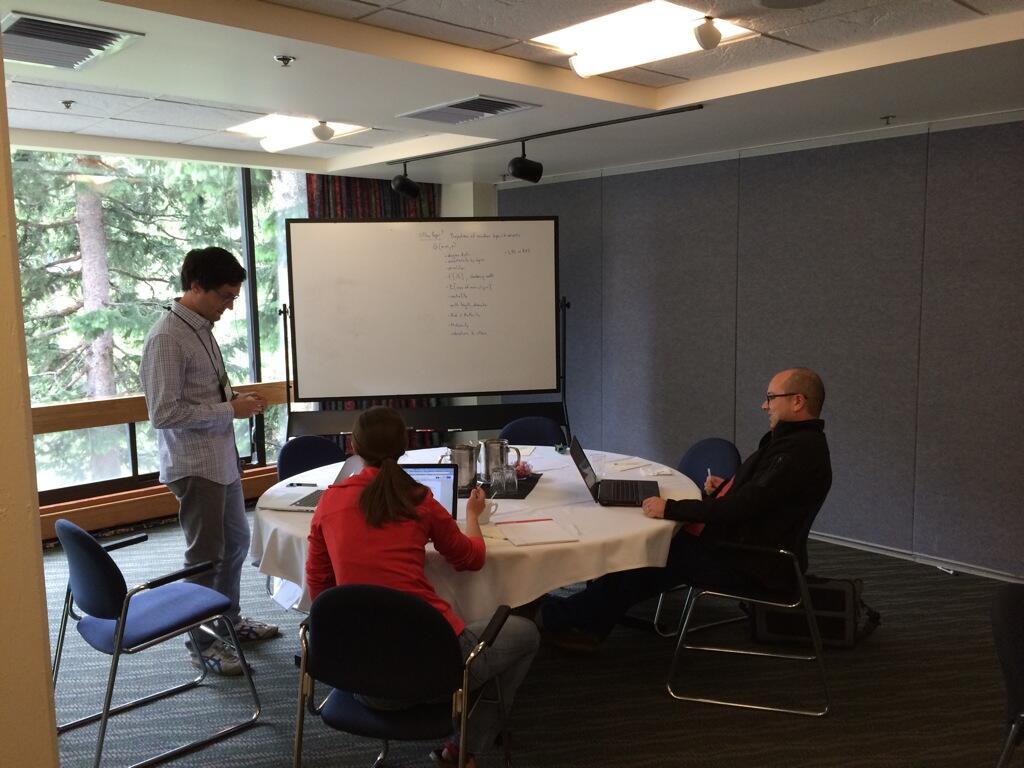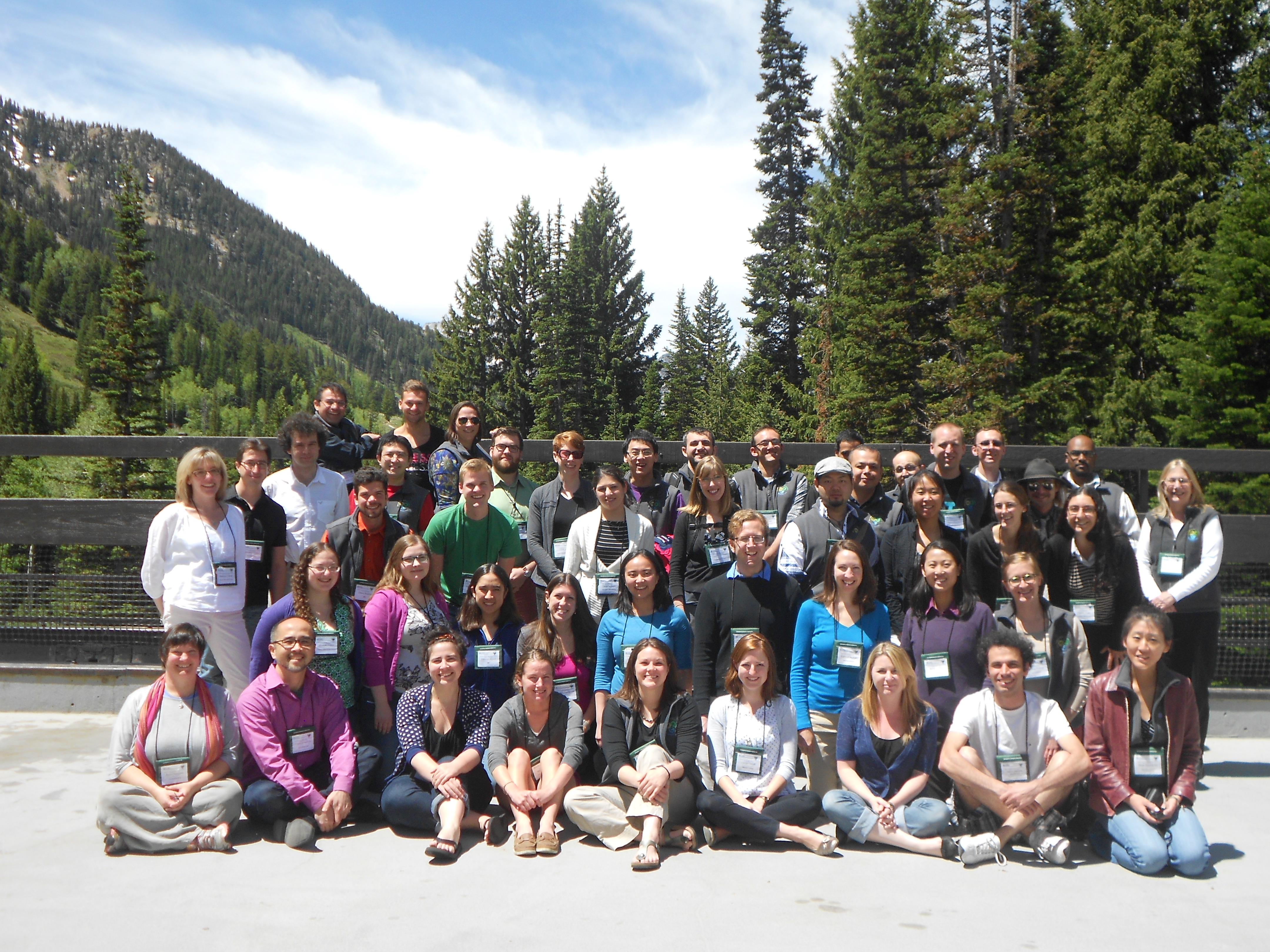The 2014 Mathematics Research Communities (MRC) summer conferences were held at the Snowbird Resort in Utah, June 8 - June 30. The four week-long conferences drew 120 early-career mathematicians. These conferences, funded by the National Science Foundation, are part of the AMS program that will include special sessions at the Joint Mathematics Meetings, a longitudinal study, and a continuation of the connections and collaborations via an electronic network.
More comments from 2014 participants:
"It was focused on developing collaborations between young mathematicians and scientists rather than simply sharing research results."
"The MRC is an extremely unique conference. It is the only conference/workshop I am aware of where the attendees get the chance to work on a specific research topic with new collaborators, and with the specific intent of solving open problems. Even more amazing: that this goal was reached and all teams emerged with new results."
"I have attended a number of conferences in my life. I learned more and did more at this meeting than I have at any of them. The open and collaborative environment was expertly maintained and very beneficial."
"The final presentation was my personal highlight because I was stunned by what each of the team accomplished in such a short time."
This year's conferences:

Week One
Cluster Algebras
June 8 – 14, 2014
Organizers: Michael Gekhtman, University of Notre Dame; Mark Gross, University of California, San Diego; Gregg Musiker, University of Minnesota; David Speyer, University of Michigan; Gordana Todorov, Northeastern University
Cluster algebras provide a unifying algebraic and combinatorial framework for a wide variety of phenomena in settings as diverse as quiver representations, category theory, quantum groups, Teichmuller theory, Poisson geometry, tropical geometry, polyhedral combinatorics, statistical physics models, discrete integrable systems, mirror symmetry, and string theory. Due to the fact that cluster-like structures appear in so many areas of mathematics and physics, the field has exploded in recent years.
Week Two
Algebraic and Geometric Methods in Applied Discrete Mathematics
June 15 – 21, 2014
Organizers:
Carina Curto, University of Nebraska-Lincoln;
Jesus A. De Loera, University of California, Davis;
Christine Heitsch, Georgia Institute of Technology;
Michael Orrison, Harvey Mudd College;
Francis Edward Su, Harvey Mudd College
This research community will introduce young mathematicians to research bridging ``pure'' mathematics and various applications amenable to the analysis of discrete models. Mathematicians trained in areas such as algebra, topology, geometry, and combinatorics are often unaware of the extent to which they are prepared to tackle open problems in fields such as biology, the social sciences, data analysis, and optimization. There is also significant benefit in attacking applied problems from a discrete perspective with algebraic, topological, geometric and/or combinatorial tools.
Week Three
A) Mathematics of Quantum Phases of Matter and Quantum Information
June 24 – 30, 2014
Organizers: Siu-Hung Ng, Iowa State University and Louisiana State University;
Eric C. Rowell, Texas A&M University;
Zhenghan Wang, Microsoft Station Q and U.C. Santa Barbara
Our long term scientific goal is to study quantum phases of matter and their applications to physics and quantum computing. A general theory formulated by Landau classifies classical phases of matter by their symmetry groups. More mysterious and challenging to understand are quantum phases of matter. The most well-studied class of quantum phases of matter is topological phases of matter (TPMs), whose low energy physics and universal properties can be modeled well by TQFTs and their variations. The algebraic models of elementary excitations of TPMs are unitary modular categories (UMCs). If a classical symmetry modeled by a group G is also present (e.g. topological insulators), then the UMC is G-graded. The prospect of utilizing TPMs to build a quantum computer has been greatly enhanced by recent experimental progress.
B) Network Science
June 24 – 30, 2014
Organizers: Aaron Clauset, University of Colorado, Boulder;
David Kempe, University of Southern California;
Mason A. Porter, University of Oxford
Over the last decade, the quantitative study of networks has emerged as a fundamental tool for understanding and modeling complex systems of all kinds. Although it has built on prior foundational work in areas such as sociology, mathematics, and computer science, the increasing availability of detailed data sets has led to insights into --- and ambitions for attaining a much deeper understanding of --- the structure, dynamics, and function of social, biological, physical, and technological systems.
|
|
 "The distinguishing feature of this conference is that there are structured opportunities for participants to work on problems in research groups. In my opinion, this is the most valuable thing that happens at the conference." "The distinguishing feature of this conference is that there are structured opportunities for participants to work on problems in research groups. In my opinion, this is the most valuable thing that happens at the conference." |
|
 "The problem solving sessions were very engaging. I felt I learned a lot. My group continued working on our problem after hours and after the workshop ended." "The problem solving sessions were very engaging. I felt I learned a lot. My group continued working on our problem after hours and after the workshop ended." |
|
 "The small problem groups were wonderful. The atmosphere (casual, relaxed, informal) made the serious math/work more possible, for lack of fear and formality." "The small problem groups were wonderful. The atmosphere (casual, relaxed, informal) made the serious math/work more possible, for lack of fear and formality." |
"The conference exceeded my expectations. It was a great experience."
About the MRC Program
The American Mathematical Society's Mathematics Research Communities program builds social and collaborative networks to inspire and sustain mathematicians who are just beginning their research careers—those who are close to finishing their doctorates or have recently finished. The structured program engages and guides all participants as they start their careers. The program includes:
-
One-week summer conference for each topic (With the exception of week 3, participants arrive on Sunday and depart the following Saturday; sessions are held Monday through Friday. For week 3, participants will arrive on Tuesday and depart the following Monday; sessions are held Wednesday through Sunday.)
-
Special Sessions at the national meeting
-
Discussion networks by research topic
-
Longitudinal study of early career mathematicians
"It is probably the most hands-on conference I have been to. Also, the followup and the possibility to meet again to finish our work is unique to this conference."
Those accepted into this program receive support for the summer conference, and will be partially supported for their participation in the
Joint Mathematics Meetings which follow in January 2015. The summer conferences of the MRC are held in the breathtaking mountain setting of the Snowbird Resort, Utah, where participants can enjoy the natural beauty and a collegial atmosphere. This program is supported by a grant from the National Science Foundation.
"Get a bunch of really good people in one place, and magic happens."
Sunset in Snowbird, Utah. Photos by Sebastian Pancratz.
Read about the 2013 Mathematics Research Communities and the MRC program.
See information on the 2015 MRC and how to apply.
Photos not credited were taken by Ellen Maycock (AMS Associate Executive Director, Meetings and Professional Services); James Maxwell (AMS Associate Executive Director for Special Projects); Michael Breen (AMS Public Awareness Officer); Robin Hagan Aguiar (Conference Coordinator, Weeks 3a & 3b).
rha 10/21/14







 "The distinguishing feature of this conference is that there are structured opportunities for participants to work on problems in research groups. In my opinion, this is the most valuable thing that happens at the conference."
"The distinguishing feature of this conference is that there are structured opportunities for participants to work on problems in research groups. In my opinion, this is the most valuable thing that happens at the conference." "The problem solving sessions were very engaging. I felt I learned a lot. My group continued working on our problem after hours and after the workshop ended."
"The problem solving sessions were very engaging. I felt I learned a lot. My group continued working on our problem after hours and after the workshop ended." "The small problem groups were wonderful. The atmosphere (casual, relaxed, informal) made the serious math/work more possible, for lack of fear and formality."
"The small problem groups were wonderful. The atmosphere (casual, relaxed, informal) made the serious math/work more possible, for lack of fear and formality."



